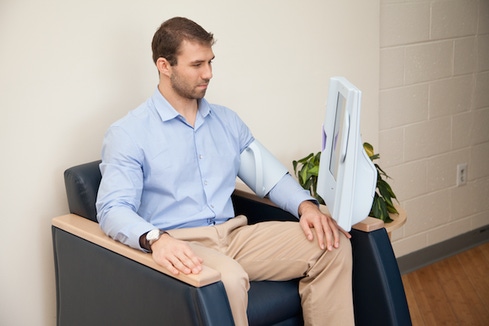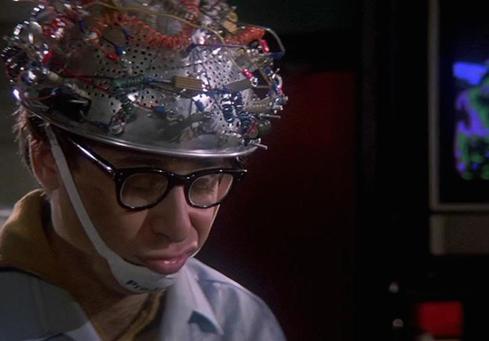The Department of Veterans Affairs installs Vecna's kiosk-based Vitals Chair at some facilities, aims to give patients more control and insight into their healthcare while streamlining practitioner workloads.


Wearable Tech: 5 Healthcare Wins
Wearable Tech: 5 Healthcare Wins (Click image for larger view and slideshow.)
The US Department of Veterans Affairs (VA) is preparing to roll out "smart chairs" in waiting rooms at a small group of hospitals and clinics. This follows the agency's nearly completed implementation of 6,000 kiosks at 1,000 sites across the United States.
The Vitals Chair, designed by the kiosk maker Vecna, is not your typical waiting-room seat. It includes an antimicrobial touchscreen with magnetic stripe, blood pressure cuff, anti-bacterial wipes, thermometer, printer, sensor, and scale -- all of which are FDA-approved, according to Vecna. The wheelchair-accessible seat has one power cord and a network cable but no hard drive, because it does not store data. It can pose questionnaires, take vital statistics, and display information to users, among other features, Ben Bau, vice president and general manager patient self-service solutions at Vecna, said in an interview.
Mike Davis, director of Veterans Point of Service (VPS), told InformationWeek that VA patients -- some of whom schedule multiple appointments at one facility in a given day -- can take their own vitals, receive a printout, and view their data online. The chairs not only allow clinicians to spend their time performing more valuable work with patients, he said, but they also give veterans more control over and insight into their vital stats.
[Sophisticated collaboration tools are creating a world of new possibilities for both clinicians and patients. Read Will Social Media Revolutionize Healthcare?]
"A business mantra we have is to change wait time into service time. The chairs create an opportunity to utilize some of that wait time," said Davis, who works for the Veterans Health Administration Chief Business Office. "We debuted them in St. Louis at the VFW convention in July and had an overwhelming response. We had repeat customers every day and oftentimes lines to test-drive the chair and kiosks."
Initially, some clinicians worried that the kiosks and chairs would eliminate jobs, he said, but that concern is far from reality. With so many patient-facing jobs required within healthcare, the VA aims to eliminate rote tasks so clinicians can focus on higher-level responsibilities. Rather than taking blood pressure and temperature, for example, clinicians can discuss side effects and symptoms -- tasks the kiosk and chair cannot do.
While many veterans prefer using the system to check in, make appointments, or update contact information, others can still opt to work with an employee, Davis said, and employees use the same kiosk software to check in patients. Some facilities use kiosks for advanced features like release of information or beneficiary travel reimbursement.
"Travel reimbursement has typically been an arduous process. There are long lines at the cashier. We've automated that on the kiosk, and it normally now takes a minute or less," said Davis. "It doesn't replace anyone because the front-line staff still has a lot to do." The kiosk-based system processes payments more quickly as the VA moves toward electronic funds transfer.
The system also includes fraud-detection capabilities through business logic. Because this is considered an advanced feature, the VA typically activates the capability 60-90 days after a launch. Currently only 12-15 sites include this feature, Davis said, but more are planned. "It captures an electronic signature like an iPad does. It's workflow re-engineering and process re-engineering."
The VA installed Vecna's kiosks primarily at busy VA hospitals and clinics, but after hearing feedback from clinicians and veterans, the agency is considering additional sites, such as rural health settings and public settings, Patricia Dear, VPS Vitals Chair senior project manager at the VA, told InformationWeek. Respondents view the chair as an effective way for veterans in remote locations to better monitor their health and potentially sound alerts when there's a problem. Davis said all vitals taken by Vecna's Vitals Chair are integrated into the VA's electronic health record and an online portal, so veterans and clinicians can see vitals digitally over time and on demand.
Vecna's kiosks and chairs are only part of what Davis sees as a multi-prong approach that includes more partnerships between the VA and other government agencies, such as the Department of Defense (DoD) and the Indian Health Service (IHS). For example, the Air Force piloted the technology early on, while Walter Reed National Military Medical Center was one of the first military health facilities to widely adopt kiosks as part of its integrated checkin approach. The DoD has also expressed interest in the chairs. If the three large agencies can work together, Davis said, members of the Armed Forces, active and retired -- as well as taxpayers -- should benefit.
"It's the same ADA-compliant kiosk, the same platform, the same vendor, and very similar -- and reusable -- capabilities, so we're considering an enterprise buy between DoD and VA, and possibly IHS," he said. "We'd like to get to the point where we can develop apps one time: Swipe once, it shows DoD data; swipe again, it shows VA data, based on the [identification] card you swipe."
This could position all three agencies to achieve a high degree of patient-facing and health administrative interoperability. By pooling their purchasing power, Davis said, the agencies should also reap a larger discount.
Bau said Vecna expects to begin a broader production schedule for its chair in early 2015. Based on its experience with the VA and other early adopters, the developer is considering additional partners, such as content providers for healthcare information or entertainment.
That would be good news for the VA as it continues to explore ways technology can help deliver health services to the almost 8 million patients it expects to serve this year. "We are firm believers that business needs should drive technology," Davis said. "We're definitely taking a bottom-up approach, listening to requirements arising from business needs from front-line staff in the field, then identifying innovative technologies and solutions that meet them."
Considering how prevalent third-party attacks are, we need to ask hard questions about how partners and suppliers are safeguarding systems and data. In the Partners' Role In Perimeter Security report, we'll discuss concrete strategies such as setting standards that third-party providers must meet to keep getting your business, conducting in-depth risk assessments -- and ensuring that your network has controls in place to protect data in case these defenses fail (free registration required).
About the Author(s)
You May Also Like







